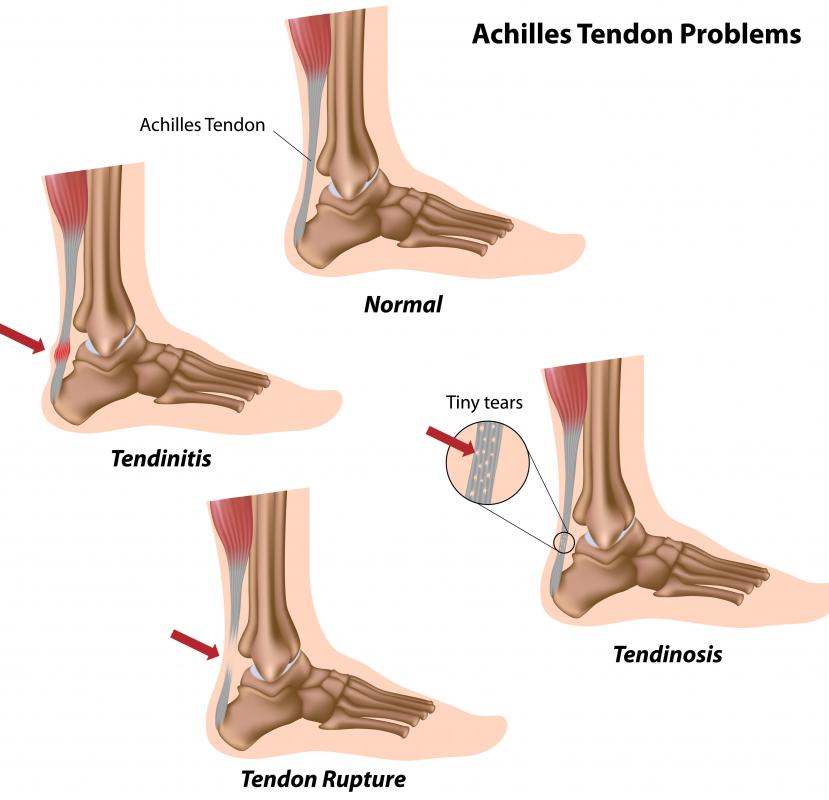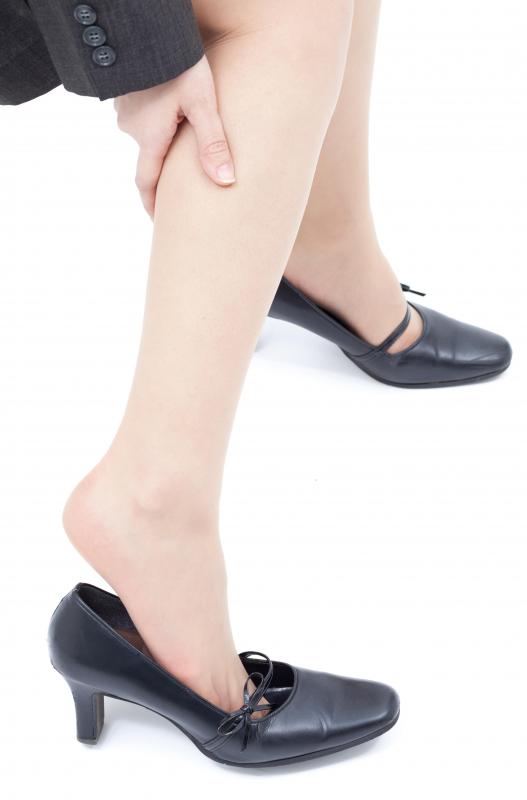At TheHealthBoard, we're committed to delivering accurate, trustworthy information. Our expert-authored content is rigorously fact-checked and sourced from credible authorities. Discover how we uphold the highest standards in providing you with reliable knowledge.
What are the Different Causes of Lower Calf Pain?
Lower calf pain is most commonly caused by pulls, tears, strains, or over extensions of the muscles in the calf. Additional causes of discomfort or tenderness might include bruising, poor circulation, insufficient nutrients, dehydration, or deformities in the muscles or tendons. Cramping is usually a temporary condition, and can be treated with heat and careful rubbing or massaging, which causes the muscles to relax.
Most calf injuries occur during exercises like walking, running, climbing, swimming, or other activities that require substantial leg movement. The best way to prevent most muscle strain is to stretch before exercising or engaging in sports. Another cause of lower calf pain could involve the calf muscles ripping away from the Achilles tendon. If the muscle separates from the tendon, surgery is usually required, followed by several months of rehabilitation to restore mobility.

Unstable blood pressure can also cause lower calf pain, and can sometimes cause swelling or hinder mobility. Burning, throbbing, or cramping sensations might indicate insufficient blood circulation, inflamed tissues, or some other problem often associated with varicose veins. Occasionally pain in the lower calves might be caused by blood clots, and could be a serious warning sign of greater health problems.

A condition called deep vein thrombosis can cause pain in the calf when blood clots form and block the veins deep in the muscles. This causes swelling and pressure, which aggravate the surrounding tissues and may be symptomatic of a stroke or other serious health concerns. Deep vein thrombosis and muscle tears — especially if the injury is tendon-related — are serious conditions that should be brought to the attention of a doctor immediately.

Lower calf pain may also indicate an imbalanced diet lacking key nutrients, vitamins, or minerals like potassium. In addition, dehydration can lead to painful burning sensations in all muscles. This condition often begins in muscle clusters, such as the calves. If the pain increases, returns, or does not lessen, it may indicate a problem that only a physician might be able to diagnose and treat.

Often, though, most causes of lower calf pain are temporary and can be self-treated. Treatments for calf injuries can include elevating the leg, applying ice packs, keeping steady pressure on the injury, resting, and sometimes taking anti-inflammatory medications. When recovering from an injury, gradual stretching and light exercise will help to strengthen the healing muscle and regain mobility. Pain relievers can also provide temporary relief of discomfort.
AS FEATURED ON:
AS FEATURED ON:
















Discussion Comments
@shell4life – I believe that cramps are the worst type of calf muscle pain. I used to wake up with these cramps in the middle of the night, and nothing I did helped relieve the pain.
Walking on the leg was impossible during a cramp, and massaging it only made it feel worse. A heating pad might have helped, but I couldn't walk to the closet to get it and plug it up!
My cramps were caused by a lack of potassium in my diet. I started eating a banana every day, and the cramps stopped.
I know that the banana is what stopped them, because there have been a few days when I have forgotten to eat one, and the cramps returned. It's good motivation to remember to eat one every day!
I sometimes get severe calf pain out of the blue. These terrible cramps hit my calves, and I want to scream out in pain!
I've heard that a lack of certain nutrients can cause this. What nutrients do I need to increase in order to stop the cramps? Also, is there anything I can do to treat them when they do occur?
I had some lower leg pain and swelling when I was diagnosed with high blood pressure. The swelling went all throughout my calf and down to my ankles and feet.
At first, I thought maybe my dress shoes were causing this, but the doctor quickly told me that I needed to be on medication for my high blood pressure. Just a few days after starting the medicine, the swelling and discomfort went away.
He also told me to watch my sodium intake. Anyone with high blood pressure needs to do this, because eating lots of salt can cause swelling and muscle pain.
My sister had a lot of lower calf pain after running. She experienced this a lot when she first started, so she decided that she needed to slow it down to a jog and gradually work up to a run. Sometimes, just jumping into a vigorous activity like that can do more harm than good.
Post your comments